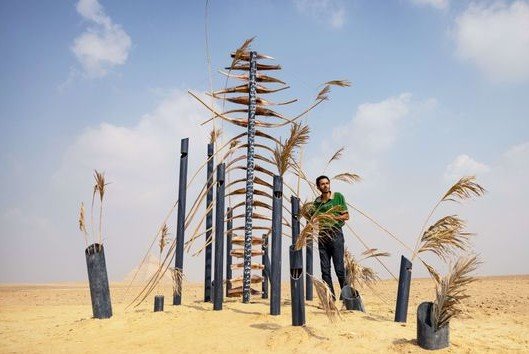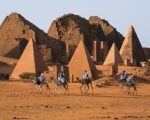An oasis known for its date palms and oil wells is now finding a voice in the heart of Dubai, thanks to a Saudi artist who sees beauty in what’s left behind.
Saudi artist Mohammad Alfaraj’s solo show at Jameel Arts Centre is more than an exhibition — it’s a memory you can walk into, sit in, and maybe even add to. His work, rooted in the landscapes and traditions of Al-Ahsa, transforms abandoned materials into an intimate space for storytelling and reflection.
A Gathering Place Built From Discarded History
Midway through the exhibition, visitors stumble upon a circular enclosure that seems both improvised and deeply intentional. The structure is made from mismatched, weathered doors salvaged from Al-Ahsa — some upright, others lying sideways — all pieced together like fragments of forgotten homes.
Inside, the floor is covered with woven reed mats. A few basic chairs face each other, encouraging visitors to linger. In the corner, a small stack of chapbooks invites you to leaf through stories, some written by Alfaraj, others left behind by strangers.
It’s called Love is to leave the door to your garden ajar. The name alone feels like an invitation — not to a polished gallery experience, but to a living room that remembers the smell of dust and date palms.
One sentence in the exhibition notes sums it up: “A storytelling space, where everyone is invited to gather, read from Alfaraj’s stories, or tell stories of their own.”

The Spirit of the Arish
The installation is inspired by the arish — a humble, palm-frond shelter used by farmers in Al-Ahsa. It’s not fancy. It was never meant to be. Built from whatever materials were available, often the fronds of date palms, the arish was a refuge from the sun and a place for conversations to stretch beyond the workday.
Alfaraj remembers them well. “Farmers used to build shelters in the fields to escape the heat. They are social spaces to share stories,” he says.
But times have changed. The wooden doors once common in the area are being replaced by cold, iron ones. For many, the shift is just about durability. For Alfaraj, it’s about what’s being lost. “I collected these abandoned doors to build a space for people to sit, read or write,” he explains.
In his hands, they’re no longer scrap. They’re fragments of lives, woven together into a new story.
Al-Ahsa: Oasis of Contrasts
Al-Ahsa isn’t just any desert town. It’s a UNESCO World Heritage site, famous for being one of the world’s largest oases. Its rich soil feeds lush date palm groves, and beneath that same ground lie some of the largest oil reserves in the world.
That duality — abundance above and wealth below — is part of what makes the region so striking. It’s a place where farmers still tend the same groves their ancestors worked, even as oil pipelines snake quietly across the land.
The table below shows just how unusual Al-Ahsa’s profile is:
| Feature | Description | Significance |
|---|---|---|
| Date Palm Groves | Over 2.5 million trees | One of the largest in the world |
| Oil Reserves | Part of Ghawar Field | Largest conventional oil field globally |
| Cultural Heritage | Traditional arish shelters, craftwork | Links to centuries-old farming traditions |
| UNESCO Status | World Heritage Site since 2018 | Recognition of cultural and natural value |
For Alfaraj, the oasis is more than just home — it’s a source of creative material, both literally and metaphorically.
A Title That Feels Like a Riddle
The exhibition itself carries the name Seas are sweet, fish tears are salty. On paper, it sounds almost like a child’s drawing of the world. In reality, it’s layered — playful, yet quietly profound.
Like much of his work, the title plays with opposites and unexpected truths. Sweet seas? Salty tears? It invites you to think, then to stop thinking and just feel.
That mix of the whimsical and the serious runs throughout the show. The installation with the salvaged doors might be the emotional centerpiece, but the surrounding works echo the same themes: resilience, change, and the beauty found in what’s overlooked.
Sound, Touch, and Memory
Step into the door circle and your senses start working overtime. The air hums with layered sounds — chanting voices, the rhythmic beat of hammers, the whisper of palm fronds swaying. These aren’t random recordings. They’re fragments of life in Al-Ahsa, pieced together to create an auditory backdrop that feels alive.
You can almost smell the palm leaves, feel the grit of sand on your skin. It’s not a passive viewing. You’re part of the scene, even if only for a few minutes.
One visitor, overheard in the space, summed it up quietly: “It’s like sitting inside someone’s memory.”
Why It Matters Now
Art often becomes a record of what might otherwise be forgotten. For Alfaraj, gathering discarded doors isn’t just about nostalgia — it’s about preserving a culture’s physical and emotional artifacts before they disappear for good.
And in a region where modernisation moves fast, these fragments remind people of slower rhythms, community bonds, and the simple act of sitting together without rushing to the next thing.
It’s an invitation to pause. To talk. To listen.








